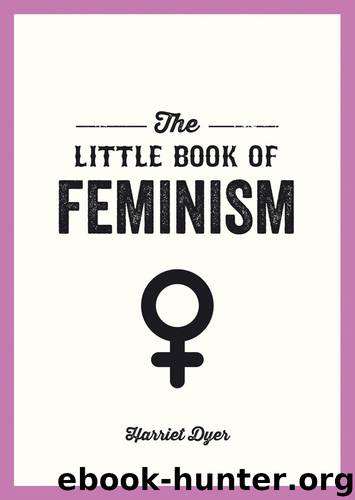The Little Book of Feminism by Harriet Dyer

Author:Harriet Dyer
Language: eng
Format: epub
Publisher: Summersdale Publisher
Landmark Acts and Laws
Finance Act 1998: This act introduced a new means of taxation known as Independent Taxation and was applicable from 1990 onwards. Previously, a married couple had been aggregated and then taxed based on the husband’s income, with responsibility for taxes also falling on the husband. The change in law meant that, although married, the husband and wife were now treated as two separate entities.
Ending the marital law rape exemption, 1991: It is shocking to think it was as recently as 1991 in England and Wales (1989 in Scotland) that by definition rape couldn’t take place within a marriage, even if the couple were separated and one member had a Family Protection Order against their spouse. Thankfully, a case of this nature was instrumental in leading to the exemption being repealed and rape within a marriage being made illegal.
The Vagina Monologues, 1996 : A play by Eve Ensler, consisting of several monologues written about the female experience and read out by different female actors. Christopher Isherwood called it the ‘most important piece of political theatre of the last decade.’ It raised awareness for topics such as rape camps, menstruation and childbirth. However, the play has also been the subject of criticism, with an act that portrays the statutory rape of a thirteen-year-old girl by an older woman in a positive light.
General Election, 1997 : The number of female MPs doubled from 60 to 120. Earlier in 1992, Betty Boothroyd had taken the role as first female speaker of the House of Commons. Labour engineered this sudden jump in female MPs with an all-women shortlist – a hot issue in modern gender politics.
Criticism
While third-wave feminism opened up the movement to welcome everyone, some felt that this left feminism without a clear aim. While it was easy to associate first- and second-wave feminism with a number of clearly defined issues, for some third-wave feminism was seen by some as more nebulous and less driven. Where it did have clear aims, such as improving media representation or an increasing in women’s shelters, some critics argued that these were simply extensions of second-wave feminism and that the third wave couldn’t be clearly defined as its own movement.
As with any movement that encompasses many different people from many different walks of life, feminism became many different things with different aims. This could also give the impression of a movement that didn’t know what it wanted: if one group of feminists was arguing for one solution, another could be found that was firmly against it. However, feminism has always had its internal divisions, from the days of the Pankhurst family to the present, and many see it as a welcome cost of inclusivity.
Third wave’s accepting ‘if you choose to do it, it’s empowering’ attitude led some to feel it was actually contributing to the harmful sexualisation and objectification of women. The flip side of accepting any free-will action as feminist meant the context in which the action occurred wasn’t criticised – if feminists acted
Download
This site does not store any files on its server. We only index and link to content provided by other sites. Please contact the content providers to delete copyright contents if any and email us, we'll remove relevant links or contents immediately.
The Rules Do Not Apply by Ariel Levy(4861)
On the Front Line with the Women Who Fight Back by Stacey Dooley(4824)
The Lonely City by Olivia Laing(4750)
Bluets by Maggie Nelson(4473)
The Confidence Code by Katty Kay(4187)
Three Women by Lisa Taddeo(3354)
Not a Diet Book by James Smith(3336)
Inferior by Angela Saini(3276)
Confessions of a Video Vixen by Karrine Steffans(3244)
A Woman Makes a Plan by Maye Musk(3202)
Pledged by Alexandra Robbins(3132)
Wild Words from Wild Women by Stephens Autumn(3092)
Nice Girls Don't Get the Corner Office by Lois P. Frankel(2995)
Brave by Rose McGowan(2785)
Women & Power by Mary Beard(2729)
Why I Am Not a Feminist by Jessa Crispin(2695)
The Clitoral Truth: The Secret World at Your Fingertips by Rebecca Chalker(2671)
The Girl in the Spider's Web: A Lisbeth Salander novel, continuing Stieg Larsson's Millennium Series by Lagercrantz David(2671)
A Burst of Light by Audre Lorde(2546)
